Katherine Marshall marvels at James Bateman's 'The Orchidaceae of Mexico & Guatemala', an elephant folio which ranks as the largest printed book ever produced on botany.
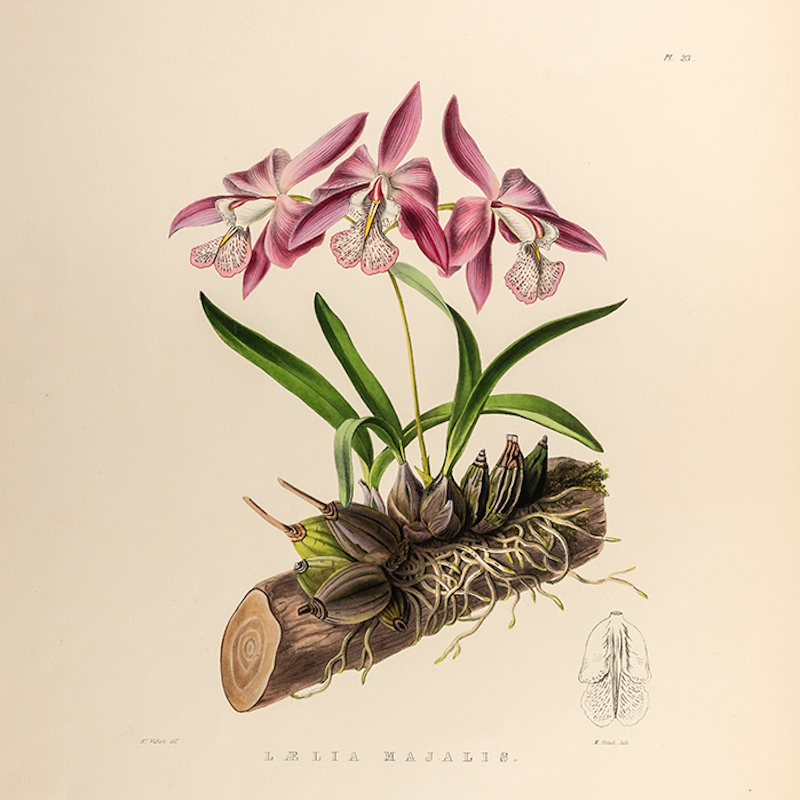
Among the oversized volumes in the Society’s collections is a copy of the largest printed book ever produced on botany, The Orchidaceae of Mexico & Guatemala (1837-1843) by James Bateman FRS (1811-1897).
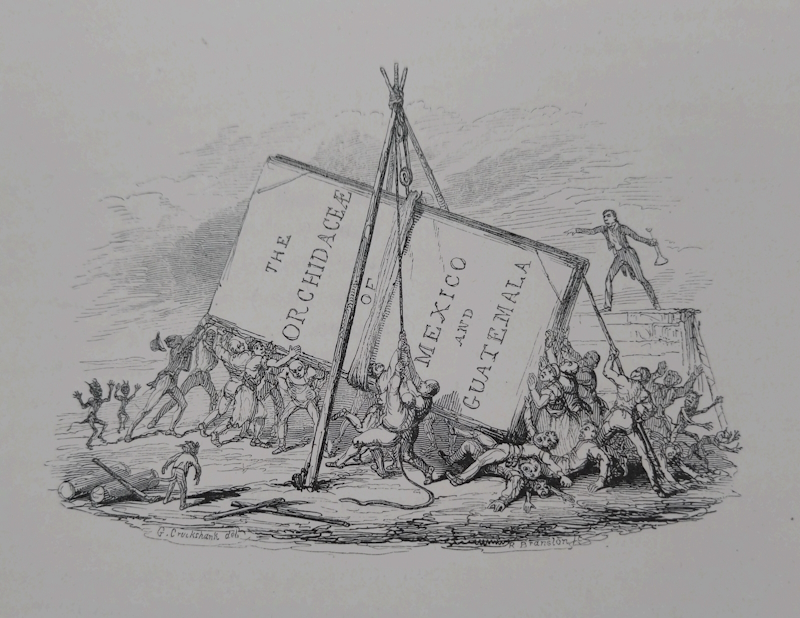
An elephant folio containing stunning lithographs of orchids, the book is so large that it contains a vignette by George Cruickshank showing the struggles of the librarians who have to handle it (above). Luckily we’ve digitised the plates for our Picture Library, so you won’t need to request the Royal Society Library’s original copy to enjoy these highly prized flowers.
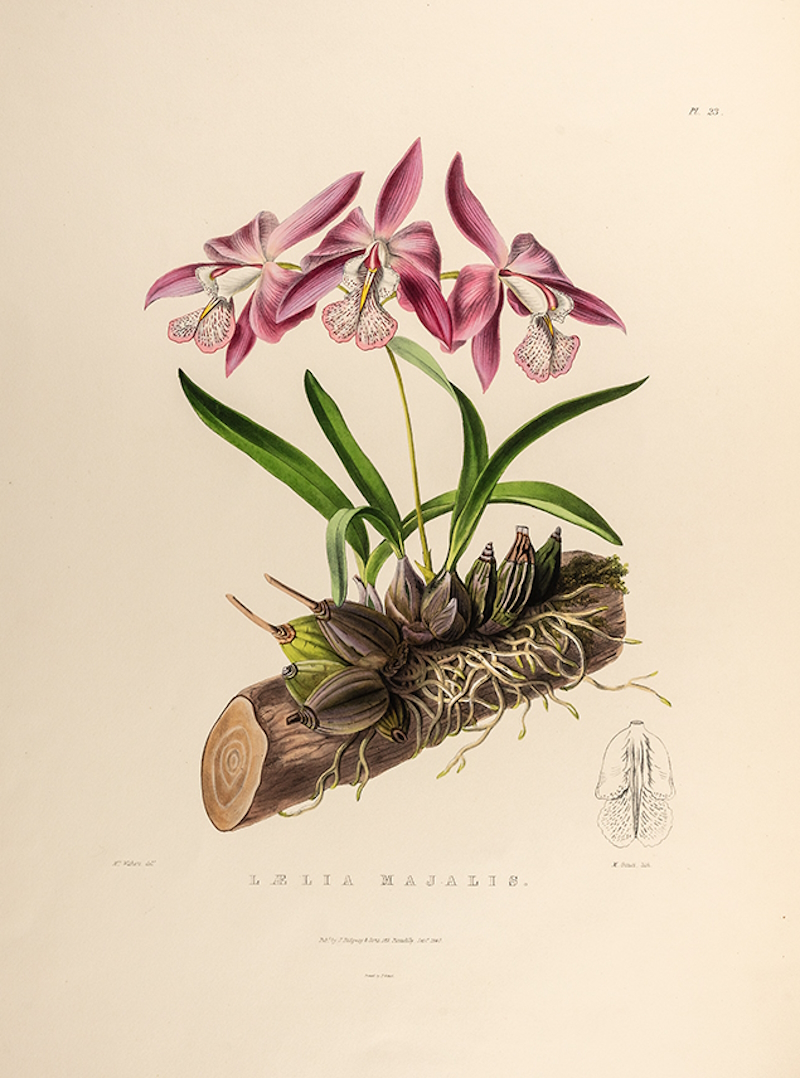 Laelia majalis by Maxim Gauci after Augusta Withers, 1840 (RS.21567)
Laelia majalis by Maxim Gauci after Augusta Withers, 1840 (RS.21567)
The Orchidaceae of Mexico & Guatemala was issued in parts and on subscription. We know that Bateman donated a copy of the first instalment to the Royal Society, as his gift is recorded in a Journal Book entry for 16 November 1837. Already a Fellow of the Linnean, Royal Geographical and Horticultural societies, Bateman was subsequently elected to the Royal Society’s Fellowship in March 1838, at the age of only 27. His proposers included John Lindley FRS (1799-1865), professor of botany at the University of London and the foremost orchidologist of the period, whom Bateman acknowledged in the preface of his book for his ‘invaluable advice and ready help’.
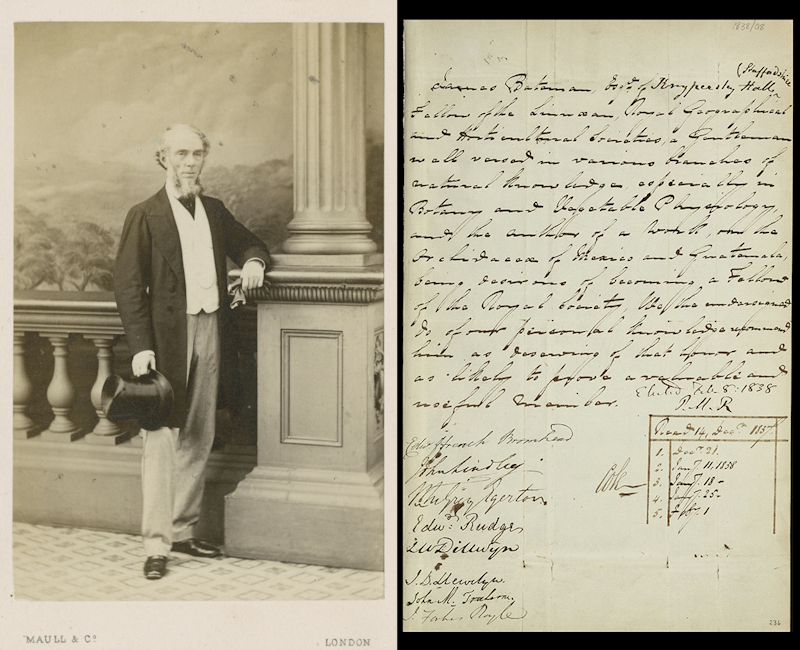 Portrait of James Bateman by Maull & Co., 1860s (RS.7763) and Bateman’s certificate of election to the Royal Society, 1838 (EC/1838/08)
Portrait of James Bateman by Maull & Co., 1860s (RS.7763) and Bateman’s certificate of election to the Royal Society, 1838 (EC/1838/08)
It was through his connection with Lindley that Bateman employed the botanical illustrator Sarah Anne Drake (1803-1857), the first of three women artists who contributed to the work. Drake, or ‘Ducky’ as she was affectionately known, was a childhood friend of Lindley’s sister. She was later employed by Lindley to illustrate his botanical works, including the monograph of orchids Sertum orchidaceum, also issued in parts from 1837 by the same publisher and printer.
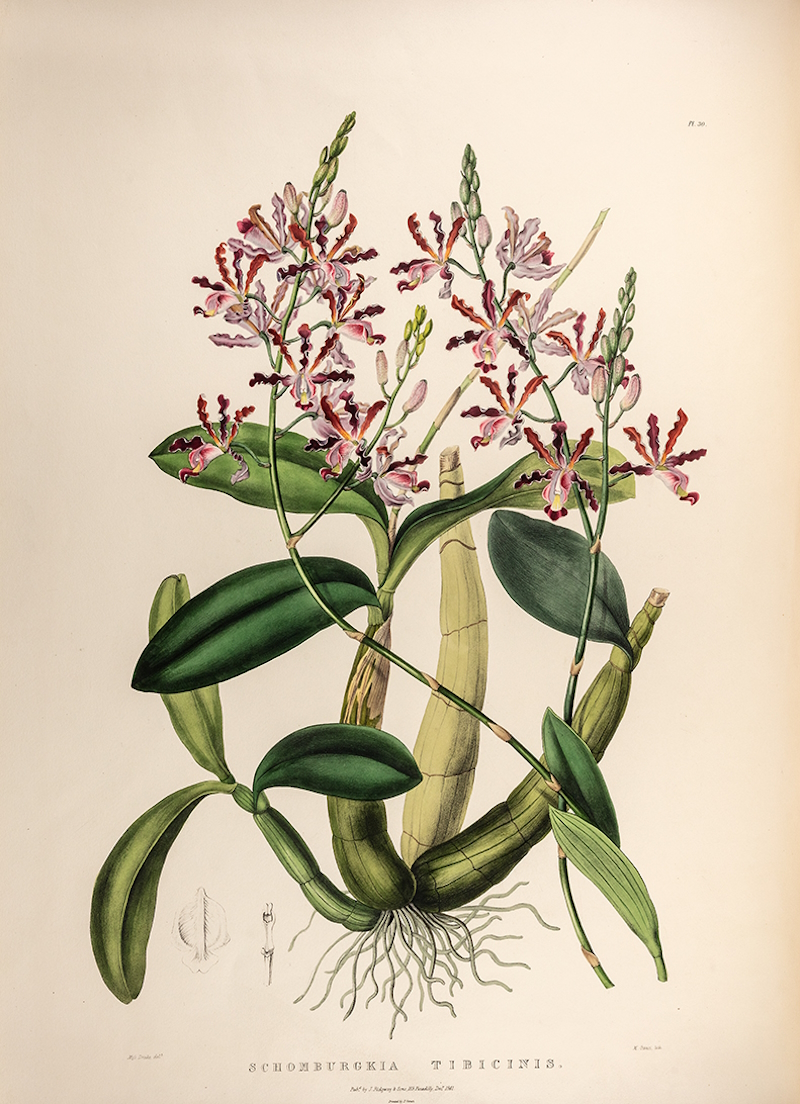 Schomburgkia tibicinis by Maxim Gauci after Sarah Drake, 1841 (RS.21574)
Schomburgkia tibicinis by Maxim Gauci after Sarah Drake, 1841 (RS.21574)
Drake contributed 16 of the 40 drawings to The Orchidaceae of Mexico & Guatemala, working alongside Augusta Innes Withers, ‘Flower Painter in Ordinary’ to Queen Adelaide. Withers was an established botanical artist, highly regarded for her ability to paint flowers and fruit accurately to show the subtle differences between varieties. Bateman, who dedicated his volume to Queen Adelaide, chose Withers to illustrate 21 specimens.
The Maltese lithographer Maxim Gauci (1774-1854) was then employed to create the extra-large illustrations using the planographic technique, not typical at the time. This, with the skilful application of colour overlay and a final varnish, gave the completed prints their softness and luminosity.
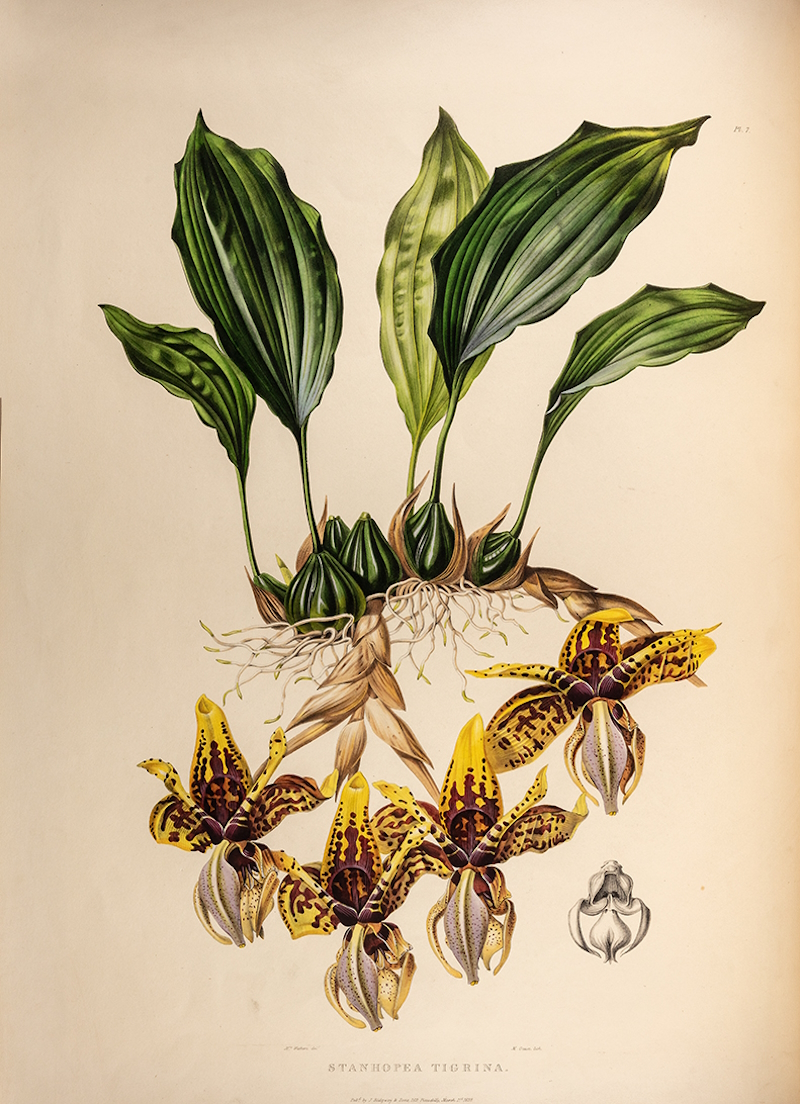 Stanhopea tigrina by Maxim Gauci after Augusta Withers, 1838 (RS.21556)
Stanhopea tigrina by Maxim Gauci after Augusta Withers, 1838 (RS.21556)
The third woman illustrator, a Miss Jane Edwards, contributed just a single painting and remains somewhat mysterious. Bateman included a touching acknowledgement for her contribution:
‘We are indebted to Miss Jane Edwards for the very beautiful drawing from which our plate is copied. Fearing that the flowers of our new Cycnoches might prove too fleeting to admit of their being sent to a professional artist in London, we were extremely perplexed as to what course to pursue, when this young lady was so kind as to relieve us from our embarrassment, by tendering the assistance of her admirable pencil, which she used in this occasion with even more than her wonted skill.’
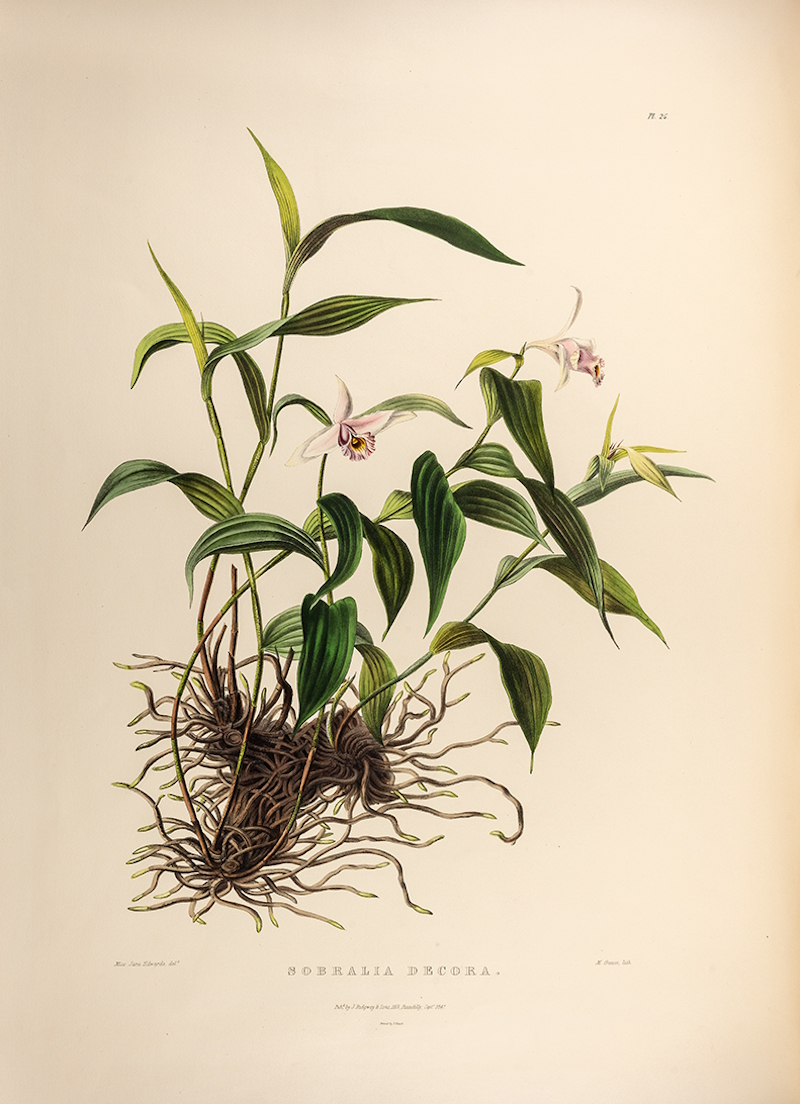 Sobralia decora by Maxim Gauci after Jane Edwards, 1841 (RS.21570)
Sobralia decora by Maxim Gauci after Jane Edwards, 1841 (RS.21570)
Out of 125 copies printed, only 55 are known to survive. The Royal Society’s example appears in excellent condition, with a vibrancy of colour and clean unmarked pages suggesting it has not been handled very much. Unfortunately, it’s missing five of the illustrations, from two parts issued in December 1839 and February 1840. Following the first instalment, the Journal Book recorded that Bateman (by then a Fellow) donated part 2 in June 1838, but a large gap followed before he gave part 5 in April 1841, continuing thereafter in an unbroken sequence till the end of the volume. I’ve not been able to establish an explanation for the missing parts 3 and 4, but it’s a great shame that we don’t have the complete set.
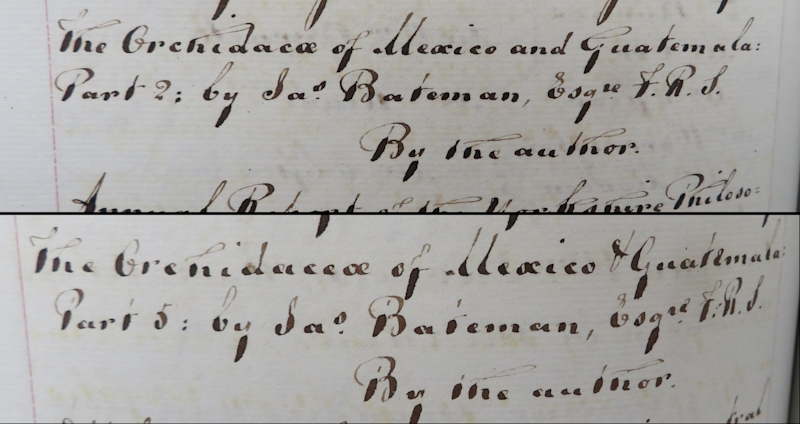 Journal Book entries for 14 June 1838 and 29 April 1841, recording the donation of parts 2 and 5 of The Orchidaceae of Mexico & Guatemala
Journal Book entries for 14 June 1838 and 29 April 1841, recording the donation of parts 2 and 5 of The Orchidaceae of Mexico & Guatemala
Bateman ascribed the contemporary obsession with the orchid, or ‘Orchido-Mania’ as he called it, to three characteristics: the beauty of the flower, the fragrance, and the longevity of the blooms. Technical advances in glasshouse design in the early nineteenth century aided the collection and cultivation of orchids by the wealthy, and it was with the sponsorship of these enthusiasts that Bateman was able to create his masterpiece. Although he believed that they were a preoccupation of the wealthy, he did predict that orchids would become a household plant, writing that ‘it is easy to foresee the arrival, and that too at no distant period, of the time when their flowers will appear as much ‘at home’ in the British drawing-room as in the Mexican temple.’
I’m not sure what Bateman would make of the mass-produced orchids sold in supermarkets today. If, like me, you’ve not achieved repeat flowering of your ‘supermarket’ orchids, you can always opt for a copy of one of Bateman’s illustrations through our Print Shop, for guaranteed longevity of bloom.

